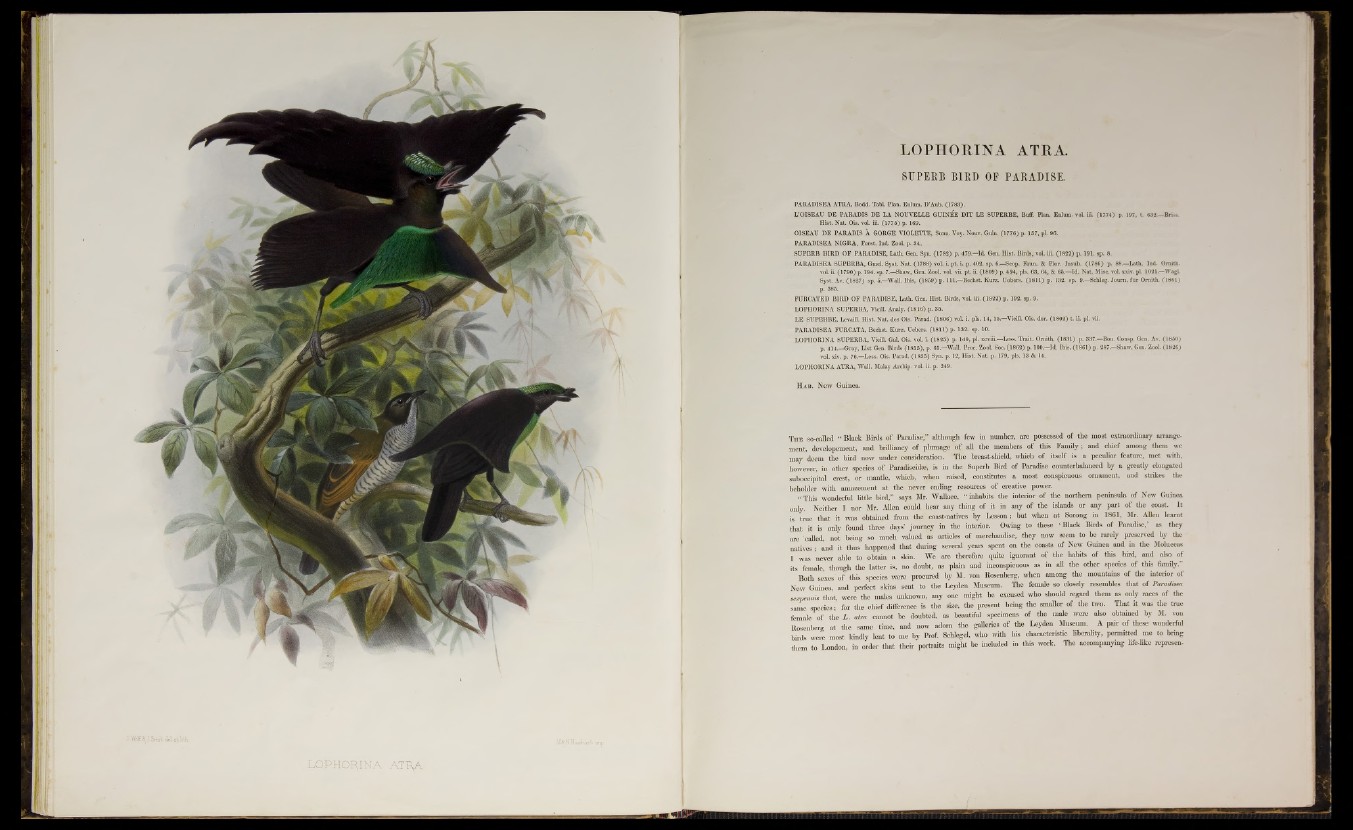
L O PH O M N A A T m
LOPHORINA ATRA.
SUPERB BIRD OP PARADISE.
PARADISEA ATRA, Bodd. Tabi. Pian. Enlum. D’Aub. (1783).
L'QISEAU DE PARADIS DE LA NOUVELLE GUINEE DIT LE SUPERBE, Bug- Pian. Enlum. voi. ili. (1 774) p. 197, t. 632.— Briss.
Hist. Nat. Ois. voi. iii. (1776) p. 169.
OISEAU DE PARADIS À GORGE VIOLETTE, Sono, Voy. Nouv. Guin. (1 776) p. 157, pi, 96.
PARADISEA NIGRA.Forat, Ind. Z oo l.p.3 4 .
SUPERB BIRD OF PARADISE, Laffi. Gen. Syn. (1782) p. 4 7 9—Id, Gen. Hist. Birds, voi, iii. (1822) p. 191. sp. 8.
PARADISEA SUPERBA, Gmel, Syst. Nat. (1788) voi. i. pt. i, p. 402. sp. 6.—Scop. Faun. & Fior. Insub. (1786) p. 88.—Lath. Ind. Ornith.
voi. ii. (1 790) p. 194. sp. 7.—Shaw, Gen. Zool. voi. vii. pt. ii. (1809) p. 494, pls, 63, 64, & 65..—Id, Nat. Mise. voi. xxiv. pi. 1021.—Wagl.
Sy s t Av. (1 827) sp. 5.—Wall. Ibis, (1869) p. I l i —Beqhst. Kurz. Uebers. (1811) p, 132- sp. 9.—Schleg. Journ, fiir Ornith. (1861)
- p. 385.
FURCATED BIRD OF PARADISE, Lath. Gen. H is t Birds, v o i iii. (1822) p. 192. sp. 9.
LOPHOR1NA SUPERBA, Viali. Analy. (1 816) p ,3 5 .
LE SUPERBE, Levali. Hist. N a t des Ois. Parad. (1 806) voi. i. pls. 1 4 ,1 5 .—Vieill. Ois. dor. (1 802) t. ii. pi. vii.
PARADISEA FURCATA, Bechst. Kurz. Uebers. (1 811) p. 132. sp. 10.
LOPHORINA SUPERBA, Vieill. Gal, Ois. vql. i. (1825) p. 149, pi, xcviii,—Less. Trait. Ornith, (1831) p . 337.—Bon. Consp. Gen. Av. (18.50)
p. 414.—Gray, List Gen. Birds (1855), p. 65.—Wall. Proc. Zool. Soc. (1 8 6 2 ) p. 100.—Id. Ibis, (1861) p. 287.—Shaw, Gen. Zool. (1826)
voi. xiv. p. 76.—Less. Ois. Parad. (1835) Syn. p. 12, Hist. Nat. p. 179, pls. 13 & 14.
LOPHORINA ATRA, Wall. Malay Archip. voi. ii. p. 249.
H a b . New Guinea.
The so-called “ Black Birds of Paradise,” although few in number, are possessed of the most extraordinary arrangement,
developement, and brilliancy of plumage o f all the members of this Family; and chief among them we
may deem the bird now under consideration. The breast-shield, which of itself is a peculiar feature, met with,
however, in other species of Paradiseidæ, is in the Superb Bird of Paradise counterbalanced by a greatly elongated
suboccipital crest, or mantle, which, when raised, constitutes a most conspicuous ornament, and strikes the
beholder with amazement at the never ending resources of creative power.
“ This wonderful little bird,” says Mr. Wallace, “ inhabits the interior of the northern peninsula of New Guinea
only. Neither I nor Mr. Allen could hear any thing of it in any of the islands or any part of the coast. It
is true that it was obtained from the coast-natives by Lesson; but when at Sorong in 1861, Mr. Allen learnt
that it is only found three days’ journey in the interior. Owing to these ‘Black Birds of Paradise,’ as they
are called, not being so much valued as articles of merchandise, they now seem to be rarely preserved by the
natives ; and it thus happened that during several years spent on the coasts of New Guinea and in the Moluccas
I was never able to obtain a skin. We are therefore quite ignorant of the habits of this bird, and also of
its female, though the latter is, no doubt, as plain and inconspicuous as in all the other species of this family.”
Both sexes'of this species were procured by M. von Rosenberg, when among the mountains of the interior of
New Guinea, and perfect skins sent to the Leyden Museum. The female so closely resembles that of Paradisea
sexpennis that, were the males unknown, any one might be excused who should regard them as only races of the
same species; for the chief difference is the size, the present being the smaller of the two. That it was the true
female of the L. atra cannot be doubted, as beautiful specimens of the male were also obtained by M. von
Rosenberg at the same time, and now adorn the galleries of the Leyden Museum. A pair of these wonderful
birds were most kindly lent to me by Prof. Schlegel, who with his characteristic liberality, permitted me to bring
them to London, in order that their portraits might be included in this work. The accompanying life-like represen